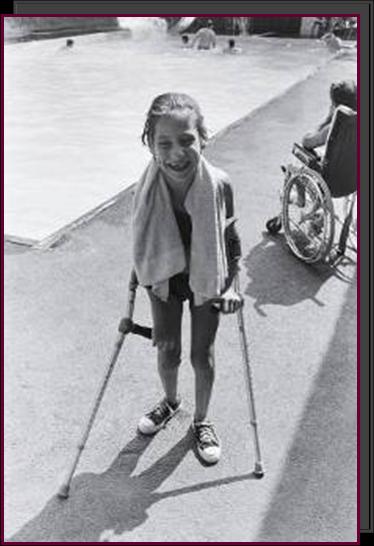INformation Hub
Spina Bifida
Spina Bifida
 Resources updated July 2015
Resources updated July 2015
In This Publication:
- Juan José’s story
- About spina bifida
- Incidence
- Characteristics & health considerations
- Help for babies and toddlers
- Help for school-aged children
- Educational implications
- Resources of more information

Juan José’s Story
This story comes to you from the Real Stories collection of the Spina Bifida Association.
I remember when the doctors told me my child had hydrocephalus and myelomeningocele and that he would not be able to do anything that another child would do. I was devastated to say the least!
Through the years, my son has proved them wrong time and time again by overcoming obstacles that having Spina Bifida can give. He spoke his first sentence at nine months old, he crawled on time, he used a wheelchair for the first time at 12 months old. My son is now an honor student in “regular” education classes and very active in wheelchair sports. He has many friends and excels in everything that he does.
Spina Bifida Association, Real Stories 1
About Spina Bifida
Spina bifida is one of the most common birth defects in the United States, affecting some 1,500 babies each year. 2 Spina bifida happens during the first month or so of pregnancy and means that the baby’s spine did not close completely. Damage to the nerves and the spinal cord may result.
In general, there are three types of spina bifida. These are:
Spina bifida occulta: In this mildest form of spina bifida, there’s a small defect or gap in one or more of the vertebrae (bones) of the spinal column. The defect may not be visible at birth and causes no harm. In fact, it’s estimated at 15% of healthy people have spina bifida occulta and don’t even know it. An X-ray of their back at some point later in life may reveal the condition. 3
Meningocele: In this form of spina bifida, the protective covering around the spinal cord (called the meninges) has pushed out through the opening in the vertebrae as a sac called the “meningocele.” But the spinal cord is not in this sack, so there’s little or no damage to the nerve pathways.
Myelomeningocele: This is the most severe form of spina bifida, where a portion of the spinal cord itself protrudes through the back. In some cases, sacs are covered with skin. In others, tissue and nerves are exposed. This needs to be corrected surgically within 24 to 48 hours after birth, but some degree of nerve damage has already occurred and more severe disabilities can result. These may include problems with bladder and bowel control and partial or total paralysis of the parts of the body below where the spinal opening was. It’s not unusual to hear the terms “spina bifida” and “myelomeningocele” used interchangeably.
Incidence
Spina bifida occurs in about 7 out of every 10,000 babies born in the United States. 4 Most of these (95%) have the myelomeningocele form of the birth defect.
Reducing the risk of spina bifida | Research has shown that if all women who could possibly become pregnant were to take a multivitamin with folic acid, the risk of neural tube defects like spina bifida could be reduced by up to 70%!
Folic acid is a B-vitamin that helps build healthy cells. Since spina bifida occurs early in pregnancy, often before a woman knows she is pregnant, it is important that women of child-bearing age take folic acid every day. 4
Characteristics and Health Considerations
The effects of spina bifida vary from person to person, depending on the type involved. Children born with spina bifida occulta typically have few symptoms or adverse effects from the condition. As we mentioned, many may never even know that they have it. Those with meningocele, also a mild form, may be only minimally affected as well.
The effects of myelomeningocele, the most serious form of spina bifida, may include:
- muscle weakness or paralysis below the area of the spine where the incomplete closure (or cleft) occurs,
- loss of sensation below the cleft, and
- loss of bowel and bladder control.
Hydrocephalus | In addition, fluid may build up and cause an accumulation of fluid in the brain (a condition known as hydrocephalus). A large percentage (70%-90%) of children born with myelomeningocele have hydrocephalus.
Hydrocephalus is controlled by a surgical procedure called “shunting,” which relieves the fluid buildup in the brain. If a drain (shunt) is not implanted, the pressure buildup can cause brain damage, seizures, or blindness. Hydrocephalus may occur without spina bifida, but the two conditions often occur together.
Latex allergies | Research has found that up to 73% of children and adolescents with spina bifida are sensitive to natural rubber latex, the substance often used to make surgical gloves. 5 (Synthetic latex is not a problem, because it is man-made.) Symptoms can include watery eyes, wheezing, hives, rash and even life-threatening breathing problems,6 which is why the Spina Bifida Association strongly recommends that families avoid contact with latex products in all settings from birth. See SBA’s full list of recommendations and suggestions online (including a list of latex products and alternatives to those products), at: http://tinyurl.com/yjjfn6o
Help for Babies and Toddlers
Although spina bifida is relatively common, until recently most children born with a myelomeningocele died shortly after birth. Now that surgery to drain spinal fluid and protect children against hydrocephalus can be performed in the first 48 hours of life, this is no longer true. Children with spina bifida now go on to live full and active lives. They will, however, need extensive help and support to address the effects that spina bifida can have in key developmental areas. Frequent medical tests, surgeries, and hospitalizations are not uncommon. 7
Parents should know that there is a lot of help available for most babies and toddlers with spina bifida, especially those with myelomeningocele. Of particular note is the early intervention system that’s available in every state.
Early intervention is a system of services designed to help infants and toddlers with disabilities (until their 3rd birthday) and their families. It’s mandated by the IDEA, the nation’s special education law. If a child with spina bifida is found eligible for early intervention services (and most are), staff work with the child’s family to develop what is known as an Individualized Family Services Plan, or IFSP. The IFSP will describe the child’s unique needs as well as the services he or she will receive to address those needs.
The IFSP will also emphasize the unique needs of the family, so that parents and other family members will know how to support their young child’s needs. Early intervention services may be provided on a sliding-fee basis, meaning that the costs to the family will depend upon their income.
To access early intervention services in your area
Ask your child’s pediatrician for a referral. You can also call the local hospital’s maternity ward or pediatric ward, and ask for the contact information of the local early intervention program.
To learn more about early intervention, including how to write the IFSP, visit the Babies and Toddlers section of our site.
Help for School-Aged Children
Just as IDEA requires that early intervention be made available to babies and toddlers with disabilities, it requires that special education and related services be made available free of charge to every eligible child with a disability, including preschoolers (ages 3-21). These services are specially designed to address the child’s individual needs associated with the disability—in this case, spina bifida.
If the child is found eligible for services, school staff will work with his or her parents to develop an Individualized Education Program, or IEP. The IEP is similar to an IFSP. It describes the child’s unique needs and the services that have been designed to meet those needs. Special education and related services are provided at no cost to parents.
There is a lot to know about the special education process, much of which you can learn here at the Center for Parent Information and Resources, which offers a wide range of publications on the topic. Visit our special education pages.
Educational Implications
Quite often, children with myelomeningocele will need to have a series of operations throughout their childhood and school years. School programs should be flexible to accommodate these special needs.
Many children with myelomeningocele need training to learn to manage their bowel and bladder functions. Some require catheterization, or the insertion of a tube to permit passage of urine.
The courts have held that clean, intermittent catheterization is necessary to help the child benefit from and have access to special education and related services. A successful bladder management program can be incorporated into the regular school day. Many children learn to catheterize themselves at a very early age.
In some cases, children with spina bifida who also have a history of hydrocephalus experience learning problems. They may have difficulty with paying attention, expressing or understanding language, and grasping reading and math. Early intervention with children who experience learning problems can help considerably to prepare them for school.
Successful integration of a child with spina bifida into school sometimes requires changes in school equipment or the curriculum. In adapting the school setting for the child with spina bifida, architectural factors should be considered. Section 504 of the Rehabilitation Act of 1973 requires that programs receiving federal funds make their facilities accessible. This can occur through structural changes (for example, adding elevators or ramps) or through schedule or location changes (for example, offering a course on the ground floor).
Children with myelomeningocele need to learn mobility skills, and often require the aid of crutches, braces, or wheelchairs. It is important that all members of the school team and the parents understand the child’s physical capabilities and limitations.
As Juan José’s story at the beginning of this fact sheet illustrates, families and teachers can play a key role in promoting the personal growth and independence of children with spina bifida. The foundations of that independence are laid a step at a time. Take advantage of the wealth of knowledge and insight that’s available through the organizations listed in the References and the Resources sections of this fact sheet.
Resources
Spina Bifida Association of America
1.800.621.3141
sbaa@sbaa.org | www.spinabifidaassociation.org
Information in English and Spanish.
March of Dimes Birth Defects Foundation
1.914.997.4488
http://www.marchofdimes.com
Information in English and Spanish.
Easter Seals—National Office
1.800.221.6827
http://www.easterseals.com/site/PageServer
Information in English and Spanish.
National Institute of Neurological Disorders and Stroke | National Institutes of Health
http://www.ninds.nih.gov/disorders/spina_bifida/detail_spina_bifida.htm
Information in English and Spanish.
References
1 | March of Dimes. (2009, August). Spina bifida. Available online at:
http://www.marchofdimes.com/baby/spina-bifida.aspx
2 | Centers for Disease Control and Prevention. (2010). Data and statistics. Available online at: http://www.cdc.gov/ncbddd/spinabifida/data.html
3 | Spina Bifida Association. (2008). Spina bifida. Available online at: http://tinyurl.com/3qegx2y
4 | Spina Bifida Association. (2008). What can be done to reduce the risk? Available online at: http://tinyurl.com/6yxqzf
5 | Spina Bifida Association. (2008). Latex (natural rubber) allergy in spina bifida. Available online at: http://spinabifidaassociation.org/project/natural-rubber-latex-allergy
6 | March of Dimes. (2009). Birth defects: Spina bifida. Available online at: https://www.marchofdimes.org/complications/spina-bifida.aspx
7 | Rowley, L. (2007). Welcoming babies with spina bifida: A message of hope & support for new & expectant parents. Available online at the Children and Adults with Spina Bifida and Hydrocephalus website: http://www.waisman.wisc.edu/~rowley/sb-kids/wbwsb.html
* Highly Rated Resource! This resource was reviewed by 3-member panels of Parent Center staff working independently from one another to rate the quality, relevance, and usefulness of CPIR resources. This resource was found to be of “High Quality, High Relevance, High Usefulness” to Parent Centers.
SOURCE ARTICLE: Center for Parent Information and Resources
Give us a call at (727) 523-1130 or (800) 825-5736 or request a callback by clicking below.
311 South Missouri Ave, Clearwater, FL 33756
(727) 523-1130
(800) 825-5736

